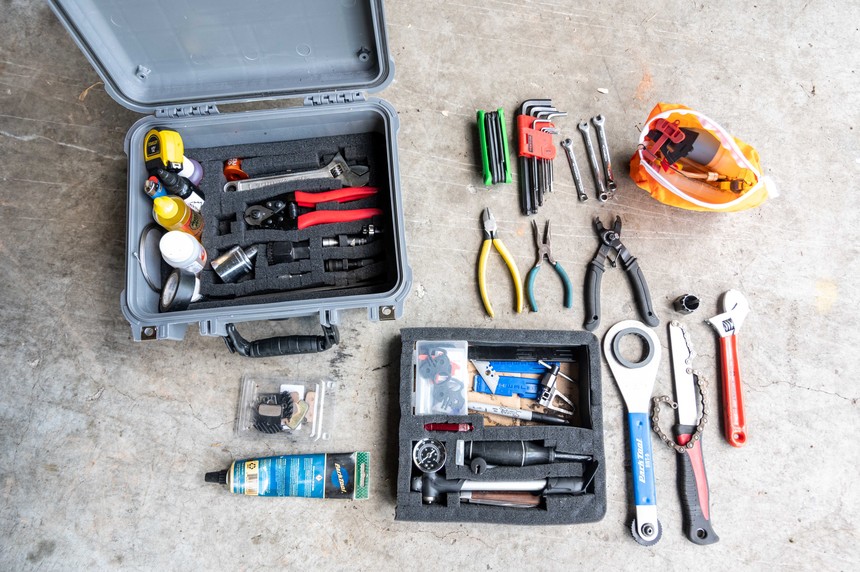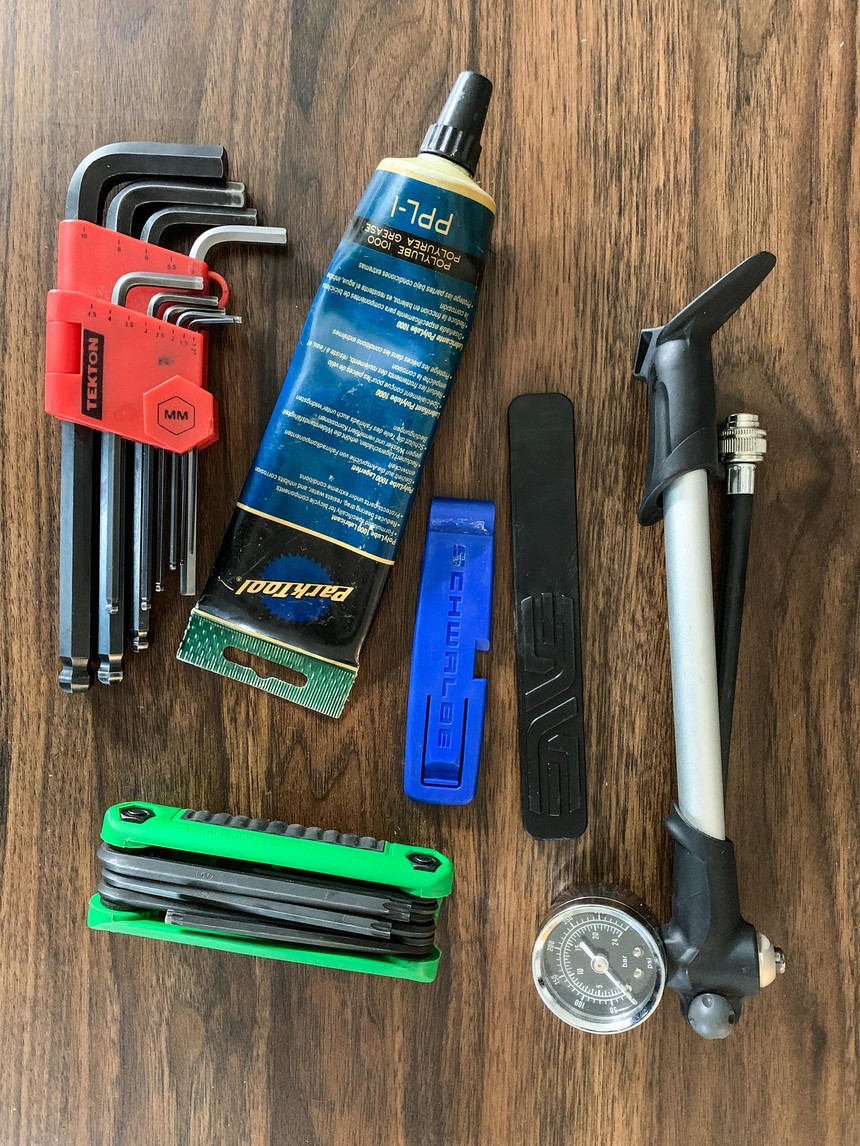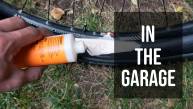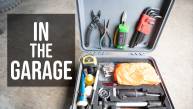 For Episode 2 of In the Garage, we'll walk you through what's in our ideal bike tool box set. Max Ritter photo.
For Episode 2 of In the Garage, we'll walk you through what's in our ideal bike tool box set. Max Ritter photo.
Working on bikes is really just fun and games, but it’s not really something you can do without a proper tool kit. Sure, your favorite 15-piece pocket multitool might help you out on the trail, but when it comes down to really getting stuff dialed on your bike, investing in a proper set of bike-specific tools will go a long way – and might even save you some cash down the line when you don’t have to go to the bike shop for a simple fix.
RELATED: In The Garage - Early Season MTB Check-Up
For Episode 2 of TGR’s In The Garage, I’ll walk you through what tools you’ll need to complete the most common repairs on a mountain bike. Some of these are essential for any task, while others are much more specialized, so I’ve broken down the list into three categories. It is possible to buy “complete” repair kits from many awesome brands like Park Tool, Pedros, and others, but it’s just as easy to find these tools individually online or in a shop and put together a custom kit like I have been using for years. After working in shops alongside some of the best pro mechanics, I garnered an appreciation for organization in my toolbox - so I went full World Cup race mechanic and make sure every tool has its place in a protective waterproof box.
 Everything has its place in the box. Maybe I'm a little OCD with it. Max Ritter photo.
Everything has its place in the box. Maybe I'm a little OCD with it. Max Ritter photo.
The Basics
Bike Stand – There’s really nothing worse than seeing someone try to work on a bike without a proper bike stand. It’s like working on a car without a lift. There’s no need for anything fancy here, just as long as it supports your bike’s weight and clamps by the seatpost. It’ll make any job that much easier.
Ball Head Allen Key Set – Metric Allen keys (or hex keys) are probably the most common tool you’ll ever use on a bike. Invest in a set that has ball ends, which will make turning bolts in hard-to-reach places much easier. Make sure to have the following sizes: 1.5mm, 2mm, 2.5mm, 3mm, 4mm, 5mm, 6mm, 8mm, 10mm and 12mm.
 Some of the absolute basics - these are the tools I use every day in the bike shop. Max Ritter photo.
Some of the absolute basics - these are the tools I use every day in the bike shop. Max Ritter photo.
Torx Key Set – Nowadays, many component manufacturers are switching to Torx-head bolts for some reason. In my opinion, they don’t offer any advantage over traditional bolts, but who am I to say? I have a multi-tool style torx set, but rarely use anything but the t20 and t25 sizes.
Floor Pump – Hand pumps are nice for trailside repairs, but a floor pump with an integrated pressure gauge will allow you to dial in tire pressures, and seat tubeless tires. Again, no need for anything fancy here.
Shock Pump – If you run air-sprung suspension, you’ll need a shock pump to dial in your pressure. Many new bikes come with shock pumps, and they work just fine, but consider one with a digital pressure gauge if you want to get exact readings every time.
Tire levers – While this is more of a trailside repair tool, a set of strong tire levers will be required should you need to swap a tire or put in more tubeless sealant at home.
Grease and Chain Lube– Grease and chain lube will keep your bike running quiet and smooth for the whole season without premature wear on parts like your drivetrain, headset, or suspension linkage. I keep a bottle of chain lube handy to lube my chain before every ride, and a tube of grease handy for just about any repair.
 Diving a little deeper, these come out for specific repairs, but are essential as well. Max Ritter photo.
Diving a little deeper, these come out for specific repairs, but are essential as well. Max Ritter photo.
Middle Ground
Chain Whip and Cassette Tool – A chain whip and cassette tool will allow you to change the cassette on your rear wheel should it wear out or need other service. The chain whip holds the teeth of your drivetrain so the cassette tool can unthread it from your rear hub. I prefer the small cast-metal cassette tools that fit into an adjustable wrench as they are more useful in other situations (some other bike components like suspension linkages and fork top caps actually have cassette tool fittings).
Box Wrench Set – Small box wrenches are necessary for more in-depth bike repairs, like brake bleeds or suspension service. I always keep a 6mm, 7mm, and 8mm on hand.
Wire and Housing Cutters – When installing new shifter or dropper cables or messing with zip ties on your frame, wire cutters are your best friend. However, they usually won’t cut it (pun intended) when you have to shorten cable housing. That’s where dedicated housing cutters (bigger and sharper than wire cutters) come in.
Chain Tool and Quicklink Tool – Replacing a worn or broken chain will require using both a chain tool and quicklink tool. The chain tool pushes the fixed pins of a chain link out to facilitate removal, while the quicklink tool is a set of specialized pliers that grab SRAM or Shimano quick links to pop them open.
Valve Core Remover – This nifty little tool is crucial for setting up tubeless tires. It pulls the valve core out of your valve stem, allowing you to inject tubeless sealant into a seated tire without having to pull it off the rim.
Bottom Bracket Tool – Removing a creaky bottom bracket requires a bottom bracket tool, essentially a special wrench that engages to slots machined into your BB shell. They come in various sizes, so make sure you have the correct size that fits your bike’s bottom bracket.
 For higher-level repairs like brake bleeds and suspension work, these come out to play. Max Ritter photo.
For higher-level repairs like brake bleeds and suspension work, these come out to play. Max Ritter photo.
Specialty Tools
Bleed Kit – Bleed kits are dependent on the brand and model of brake you plan to bleed. Across my bikes, I have a variety of Shimano, SRAM, and TRP brakes, and they all require a different bleed system to properly service. A bleed kit will consist of a set of syringes, cups, and hoses that help pull air bubbles out of the brake fluid in your system. Invest in whichever one your brake requires, and make sure to keep it clean by flushing it with isopropyl alcohol after each use to prevent harmful DOT fluid or messy mineral oil from getting everywhere. Never mix DOT and Mineral Oil systems!
Derailleur Hanger Tool – This really should be in basic tools, but in all reality, it’s a tool I break out maybe once a year, so it’s really not that necessary. Essentially a long lever that threads into a bent derailleur hanger, it allows you to straighten and align the hanger with your rear wheel.
Torque Wrench – A torque wrench is expensive, but if you are worried about tightening bolts to the manufacturer’s printed specs, get one. It’s the only way to ensure that you’re tightening that linkage bolt to 22 Nm and not 19.
Specialty Suspension Tools – This is an open-ended list, as pretty much every fork and shock on the market will require some sort of specialty tool specific to that model to service. I have a collection of tools and adaptors from Rock Shox, FOX, and other brands specific to forks I’ve owned.












